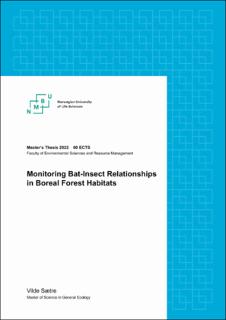| dc.description.abstract | Insect populations have over the last decades experienced global declines caused by anthropogenic disturbances, e.g., land-use changes, habitat loss, deforestation, and agricultural intensification. Consequently, insectivore populations are vulnerable because of reduced prey populations. Bats living at northern latitudes are especially vulnerable to changes in their food resources, as they experience shorter nights in the summer months compared to conspecifics living at lower latitudes. Additionally, bats living at northern latitudes are often constrained by less preferable weather conditions under the same high energy demands as those conspecifics. Evidence-based conservation of insectivorous bats requires knowledge about changes in both bat and insect abundance. There is a strong need for efficient methods for monitoring insect- insectivore relationships at different spatial and temporal scales. Non-invasive techniques have with time become a more accessible and affordable tool providing knowledge about wildlife populations with minimal degree of disturbance. Here I have investigated the ability of insect camera traps and ultrasonic acoustic recorders to capture these insect-insectivore relationships at 12 sites of boreal mixed forest habitats in Norway. In addition, I have looked at how bat activity and insect abundance are affected by environmental context, i.e., forest density (leaf area index), day length, temperature, soil moisture and ground cover. I also studied whether the relationships between insect abundance and bat activity differs among bat foraging guilds, i.e., short range echolocators (SRE), medium range echolocators (MRE) and long range echolocators (LRE). I conducted sweep net sampling of insects to compare the effectiveness of the non-invasive camera traps with a more conventional insect sampling method. I found an overall positive relationship between insect abundance and bat activity, but the relationship depended on leaf area index. There was a clear positive relationship between insect abundance and bat activity when leaf area index was low, but not at high leaf area index values. There was a clear negative relationship between leaf area index and bat activity for all guilds, but the decline was steeper for the MRE guild. Day length and soil moisture were negatively related to bat activity. Sites with a tall vegetation ground cover had higher insect abundance and bat activity than sites with low vegetation ground cover. In conclusion, I found that using automatic camera traps can be a useful method for quantifying food abundance for insectivorous forest- dwelling bats, but for the method to work, the camera must be deployed in open areas (gaps) in the forest. | en_US |

